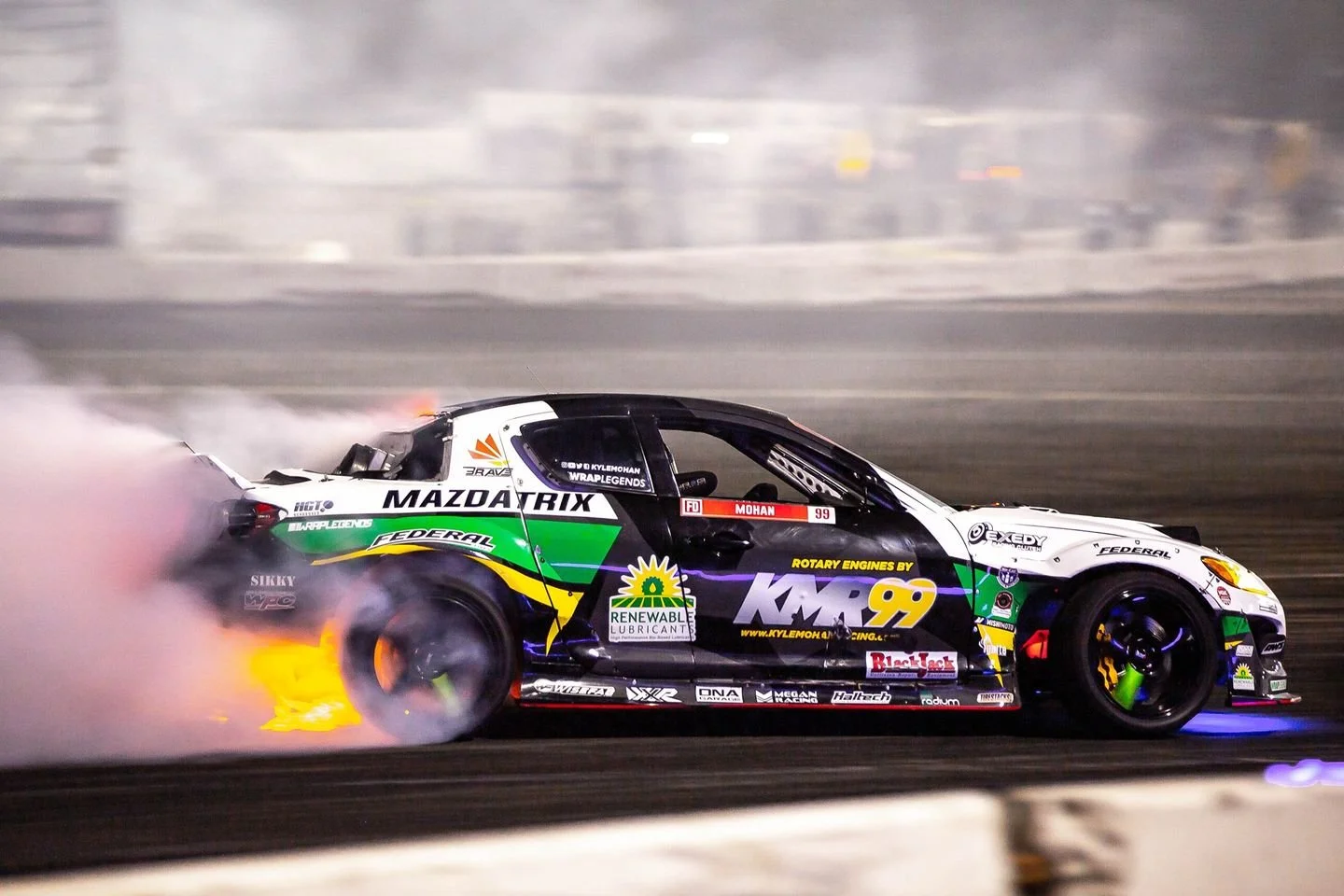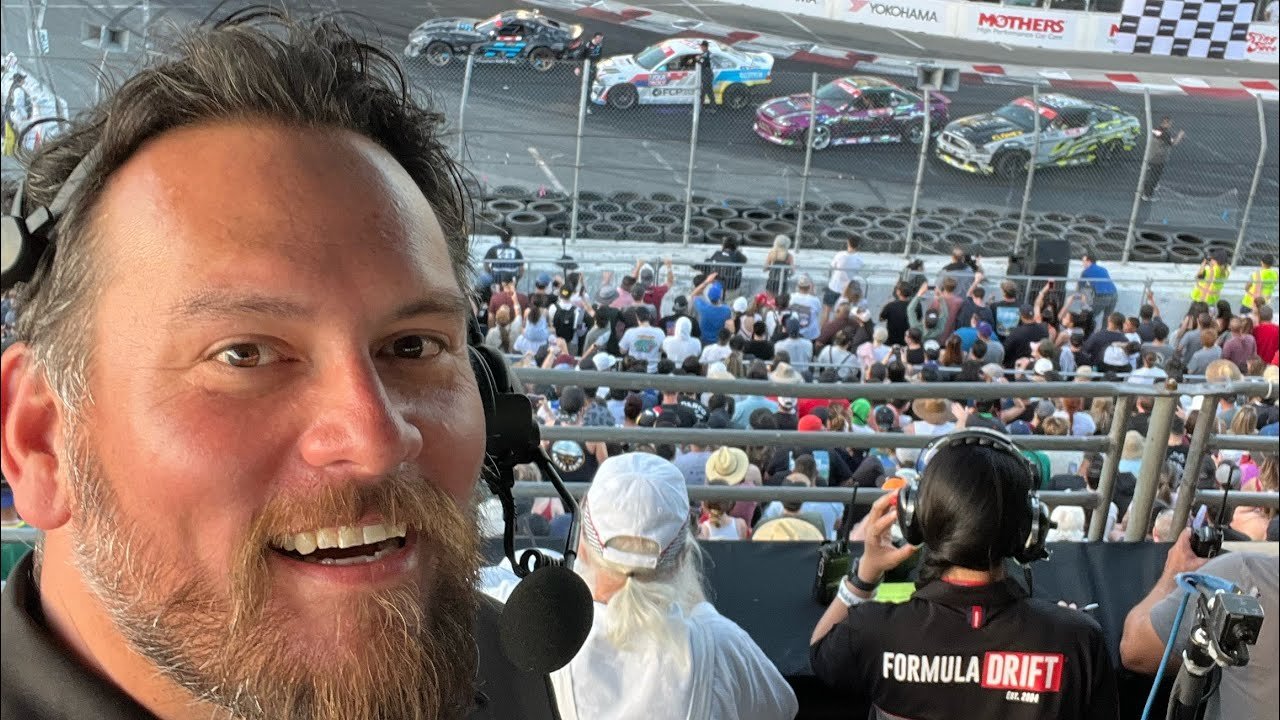DRIFTING, TUNING AND SWOONING
Photo courtesy of Larry Chen.
Hands Up For The Snaps, Crackles, And Pops Of Drifting!
The Extreme Experience of Drifting.
It’s a fact. The sport of drifting has a major mind-blowing effect on the senses. The smoking rubber alone is enough to memorialize drifting in the minds of anyone who comes in contact with it for the first time. And, that’s just one of many attributes that makes drifting an unforgettable sensory experience.
Certainly, the sport’s extreme driving styles, unique battles, all-inclusive culture, and uber-rad car scene also contribute to the magic of drifting, but in total, it’s the never-ending adrenaline rush that ultimately hooks drivers, crew members, and spectators on the sport.
“Such an incredible experience and one that surely makes the sport addicting to be around,” Stephanie Liwosz shared after going to a Formula DRIFT event for the first time this year. “You get adrenaline just from being in the stands!”
After all, what other sport can match the anticipation of watching a close tandem drift battle unfold in the blink of an eye?
How about the pure bliss on the faces of Hoonoff drivers showing their skills by burning up the pavement?
There’s also the thrill of wondering if someone’s car might break, cut power, or crash… the hope that it never does… and the angst of watching a team work against the ticking clock to bring that vehicle back to life.
Did we mention the incredible awe of seeing a driver fight hard (and play even harder) on the track? Or, that guttural desire that literally every fan has (admit it!) for getting inside a drift car to have a tire-shredding experience of a lifetime?
Every one of these experiences adds to the indelible energy rush that surges through the crowds at live drifting events. Even armchair spectators (we call these fans YouTuners) feel it when they’re glued to phones and computers to watch how the drifting competitions go down.
Photo courtesy of Kyle Mohan Racing.
All About Sound.
Yet, imagine how different it would all be without the telltale sounds that weave the world of drifting together into one big sensory tapestry.
“Cut the sound out of it, and you may as well go to a boxing match and ask every spectator to keep quiet,” the editor of crankandpiston.com wrote in the July 2014 article entitled, The Sounds of Motorsport. It Really is Necessary. “Hearing the howl of a free-breathing V8 is a treat for the ears. The combined experience is nirvana for the petrolhead soul.”
Drifting’s Base Beat.
You’ve felt it. The blood rushing through your veins each time you hear the roar of a drift car engine propelling the vehicles across a start line or around a hairpin curve.
Some of us even play the game of listening for a nuance that tells us which engine and build characteristics are ripping up the track. This is especially fun - when, for whatever reason - you can’t see who’s throwing it down.
Seriously, each drifting engine (V12, V8, 2JZ, Rotary, etc.) sounds slightly different, based on its make, configuration, exhaust enhancements, horsepower, and two dozen other tuning variables. It’s a topic that is well covered in this carthrottle.com article written by Michael Fernie. He gets down to the ‘root’ of why certain car sounds happen.
“Due to the sheer amount of moving components on a car - especially in the engine - hundreds of frequencies are produced by the car when running,” Fernie shared, further noting that engine noises aren’t the only factor involved in a car's sound. ”Whole teams of engineers in the NVH (Noise, Vibration and Harshness) sectors of a company will research the impact of different exhaust pipe diameters and constrictions to enhance or cancel out certain frequencies. Each pressure change from constricting and expanding the exhaust system will result in altered frequencies being emitted from the tailpipes.”
Photo courtesy of Larry Chen.
This is especially true at any level of drifting, because drivers vest themselves into tuning their cars to sound exactly the way they want them to. This means no two drift builds will ever sound exactly alike. Most drift teams do everything they can to accentuate an engine’s natural vibrato, while also reverse-engineering the stock soundproofing baked into the engine by the manufacturer.
This is why every Mustang will sound different from its peers on the drift track. Moreover, it’s the reason a universal motor like the 2JZ will still give off differentiated sounds, depending on which chassis it is running in, and its distinct build profile.
Certainly, a few performance-geared engines used in drifting would be loud enough without any build enhancements (think Darren Kelly’s [@darrenkelly.116] Heart of Racing V12 Twin Supercharged Aston Martin Vantage or Federico Sceriffo’s [@federicosceriffo17] 599 GTB Fiorano Ferrari, but this rarely stops a drift team from doing even more to ‘boost the noise’.
Photo courtesy of Drift Enthusiast Magazine.
Or, in some cases, they may tune it down. For example, this season, RAD Dan Burkett [@raddandrift] actually de-tuned his 2JZ MkIV Toyota Supra slightly, so it would put less stress on the motor. He’s running the same exact build, but by dialing back the exhaust profile, Dan told us he was able to, “conserve fuel, get better performance, and feel assured the car’s mechanical system is more stable and less burdened.” Right on!
However, it’s far more common for a drifting crew to do what they can to make a car sound more distinctive. Take Jonathan Hurst’s [@jonathancash16] Turbo lsx E46, for example. The crackles and pops inevitably heard from the track when Hurst is clutch kicking it are simply a byproduct of his team tuning the Beemer’s system to allow more unburnt fuel to get through to the hot pipes.
Why? Because it adds to the fun and experiences at the track, and the ruckus from Hurst’s car has created a distinctive branding element for his team in the eyes (and ears) of his fans.
Photo courtesy of Cash Racing.
"Drifting is for the fans; that's the way it should be, and one of the reasons I continue to do it,” Hurst confirmed. “My car sounds the way it does for them. It excites the crowd everywhere we go and doesn't blend in with the other sounds on the grid.”
As a privateer driver, Hurst indicated he needs to stand out, and making the car’s sound more distinctive is one way to do so.
“When you pair my car's unique sound with my aggressive driving style, it has helped us develop a pretty amazing fan base that continues to grow rapidly,” Hurst added. “The short of it is, the sound is definitely there for a reason, and it's staying until the car can't take it anymore. MLRE built one heck of an engine."
Shredding Out Loud.
Photo courtesy of Drift Enthusiast Magazine.
We can’t leave the topic of track sounds without calling out the screeches, squeals, and peels of drifting tires. At the track, and often beyond, these sounds usually mean only one of four things: fun times, a battle is brewing, a victory has been had, or someone is feeling the agony of defeat.
Think about how the sound makes all of these scenarios stick in the minds of fans and it’s easy to understand why they become meaningful memories. So, the next time you hear someone laying down rubber, at the track or elsewhere, see if you can guess what the reason behind it might be.
Drifting Silence.
A quiet drift track is never a good thing. Especially, when it’s a track that regulates the ‘sounds’ of drifting. In this case, you won’t get to hear drivers go full throttle, be aggressive with their clutch kicks, or rev up the engine ‘just because’.
Fortunately, although some tracks are still in the dark ages, it’s becoming rarer and rarer. In fact, the trend we’re seeing lately is more racetrack owners - both abroad and domestically - are now embracing the idea that drifting is here to stay.
As a result, a number of neighborhood tracks are now making invitations for organized drifting events, and many are also opening their gates to host open drift sessions. Grassroots groups everywhere are literally popping out of the woodwork to take advantage of this newfound hospitality, which gives drivers and enthusiasts alike a host of track-based drifting options.
This change of heart is also helping to curb illegal street drifting; a silencing trend many non-drifters (and law enforcement personnel) deeply appreciate (wink, wink ;)
The other silencing aspect of drifting is when drivers crash. Just like any motorsport, a crash means everyone holds their breath, silently waiting to see if the driver will emerge intact and/or the car might be too badly damaged to keep competing. As adrenalizing as a crash may be, it’s never something we want to see (or hear) happen to our friends.
Lastly, a track might go silent as a result of inclement weather. For example, in Round Two of this year’s Klutch Kickers 100k Drift Series, the weather was too intense for the competition to go on. Therefore, they were unable to identify a winner, and the incident left an unfortunate hole in the standings. Not to mention the fact that all the hard-fought battles that DID happen were ‘for not’ (if that’s even a thing in drifting…HA!)
Photo courtesy of Valters Boze.
Weather can also affect what’s happening in the stands. If it’s too hot, cold, rainy, or snowy, less spectators will be there to root for their favorite drivers.
On the other hand, weather can spice up the experience. Take Round Three of this year’s Formula DRIFT series in Orlando, Fla. Between the torrential rain that left treacherous puddles on the track, and intermittent thunderstorms, it was an event like no other. If you missed it, it’s worth pulling the event up on YouTube - just to hear all those crazy sounds!
Drift Swoon.
Finally, drifting wouldn’t be drifting without fans, and the fabulous crescendoeing sounds of fans rooting, cheering, and chanting ‘one more time!”
These sounds, along with a constant stream of oohing and awing, hooting, hollering, conversing, and laughing have now become the heartbeat of drifting events. A heartbeat that transcends the entire drifting culture from open amateur track times, to all types of competitions, to chillax drifting car shows.
The beat gets even better in the pits, where enthusiasts and crew members alike, find themselves relishing sounds like clanking wrenches, compressors, zipping tools, and revving motors.
In fact, this is where you might even hear a boombox (or two) jamming away, or if you’re lucky and paying attention, the announcer’s voice yelling “SEND it!” when the next battle is about to begin.
Photo courtesy of Jarod DeAnda.
In total, we think the sounds of drifting are one of the most important elements that make the sport what it is. We’d love to know if you agree. We’d also like to know what your favorite drifting sounds are. Let us know below in the comments section, send us a web form, or look us up on social media (see links above).










